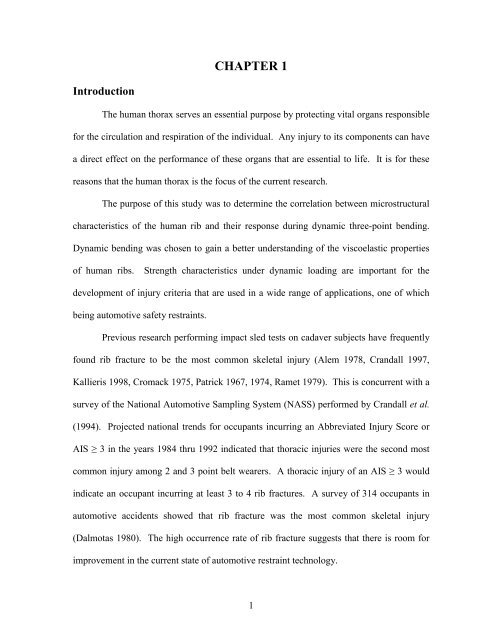Microstructural And Mechanical Properties Of Human Ribs Joseph
Microstructural And Mechanical Properties Of Human Ribs Joseph
Microstructural And Mechanical Properties Of Human Ribs Joseph
You also want an ePaper? Increase the reach of your titles
YUMPU automatically turns print PDFs into web optimized ePapers that Google loves.
Introduction<br />
CHAPTER 1<br />
The human thorax serves an essential purpose by protecting vital organs responsible<br />
for the circulation and respiration of the individual. Any injury to its components can have<br />
a direct effect on the performance of these organs that are essential to life. It is for these<br />
reasons that the human thorax is the focus of the current research.<br />
The purpose of this study was to determine the correlation between microstructural<br />
characteristics of the human rib and their response during dynamic three-point bending.<br />
Dynamic bending was chosen to gain a better understanding of the viscoelastic properties<br />
of human ribs. Strength characteristics under dynamic loading are important for the<br />
development of injury criteria that are used in a wide range of applications, one of which<br />
being automotive safety restraints.<br />
Previous research performing impact sled tests on cadaver subjects have frequently<br />
found rib fracture to be the most common skeletal injury (Alem 1978, Crandall 1997,<br />
Kallieris 1998, Cromack 1975, Patrick 1967, 1974, Ramet 1979). This is concurrent with a<br />
survey of the National Automotive Sampling System (NASS) performed by Crandall et al.<br />
(1994). Projected national trends for occupants incurring an Abbreviated Injury Score or<br />
AIS ≥ 3 in the years 1984 thru 1992 indicated that thoracic injuries were the second most<br />
common injury among 2 and 3 point belt wearers. A thoracic injury of an AIS ≥ 3 would<br />
indicate an occupant incurring at least 3 to 4 rib fractures. A survey of 314 occupants in<br />
automotive accidents showed that rib fracture was the most common skeletal injury<br />
(Dalmotas 1980). The high occurrence rate of rib fracture suggests that there is room for<br />
improvement in the current state of automotive restraint technology.<br />
1



